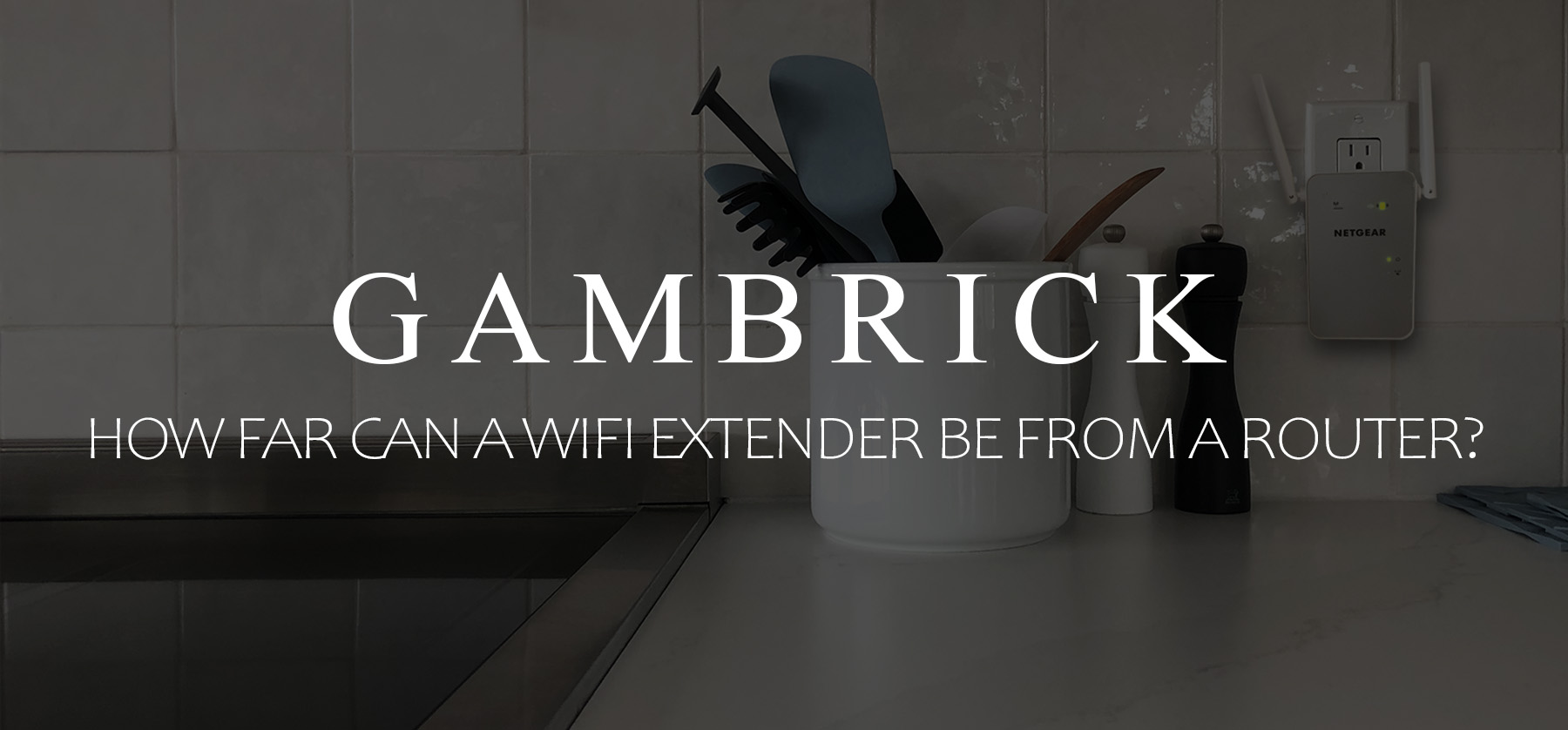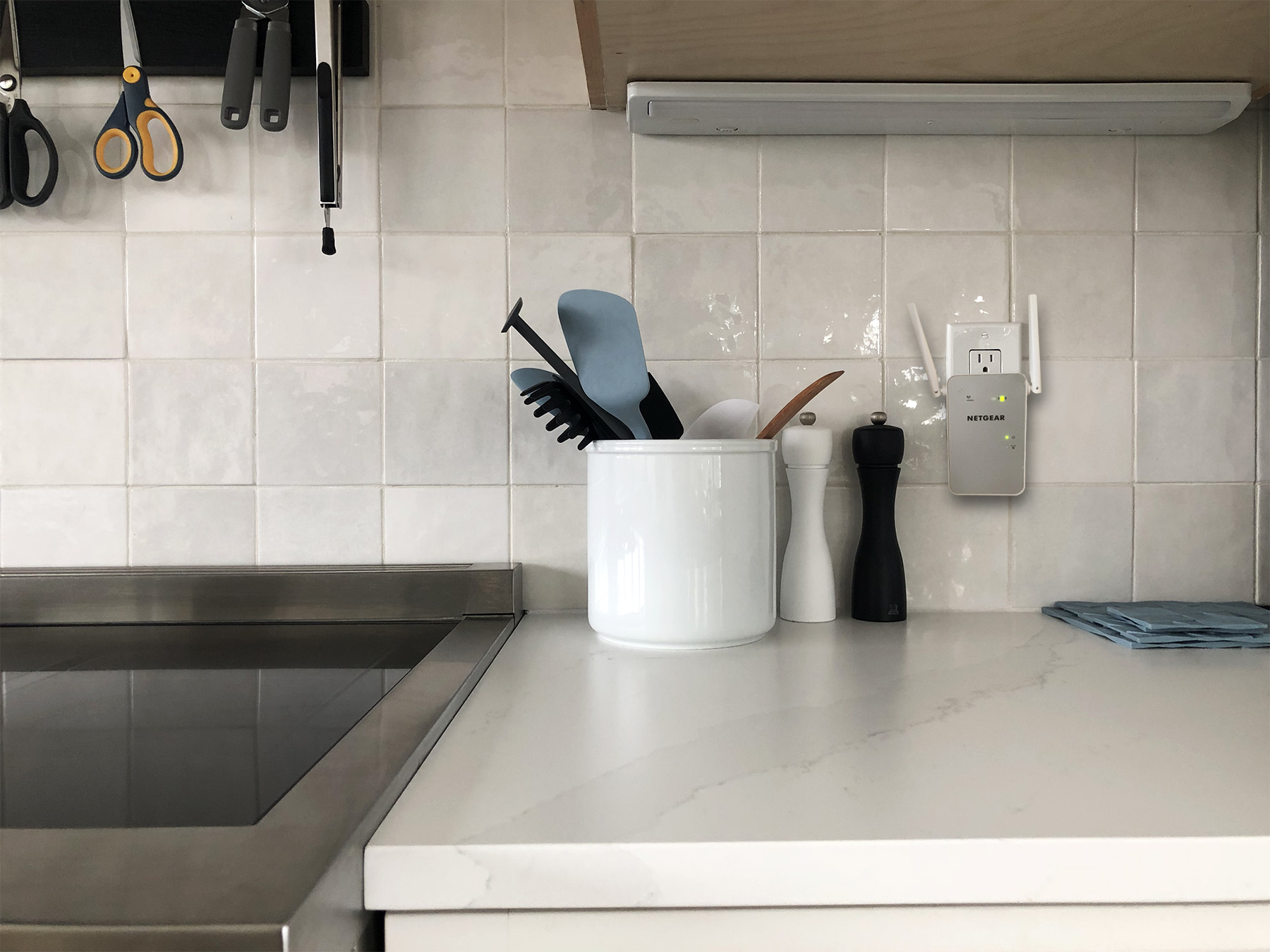How Far Can A WiFi Extender Be From A Router?
Wireless networks use a WiFi signal to communicate with other devices like a Ring Doorbell, Laptop, Smartphone or Tablet. WiFi signals are created by a Router which is connected to the Internet. The further WiFi signals travel away from the router, the weaker they get. They also have trouble when hitting solid objects like doors, walls and furniture. Or when they have to navigate around corners. If you have connection problems or a weak signal, the solution may be a WiFi extender. Most routers can send a WiFi signal about 150 feet when it’s not obstructed. WiFi extenders lengthen the range WiFi can extend from a router. A WiFi extender can be used anywhere within the router’s 150 ft WiFi range. But they work best when about 75 feet or less away from the router.
WiFi extenders work best when they’re used with devices that always stay in the same place. The best place to put a WiFi extender is halfway between a router and an electronic device. If you have a device that’s far away from the router and doesn’t get a good signal. Place a WiFi extender about halfway from the device to the router. The extender will lengthen the WiFi range to your device.
WiFi extenders can stretch a WiFi signal, but they don’t strengthen it. If you have a weak WiFi signal coming directly from the router, an extender won’t help. You probably need a new router.
How far can a WiFi extender be from a router? A WiFi extender can be used anywhere within the router’s 150 ft WiFi range, but they work best when about 75 feet or less away from the router.
The best place to position a WiFi extender is halfway between the router and your devices.
What Is A WiFi Extender?
Routers produce a WiFi internet signal which allows devices to communicate with one another and go online. Typically this range is about 150 feet. WiFi is a form of radio signal that weakens as it travels further away from the router. An extender picks up the router’s WiFi signal and then broadcasts it from the extender which lengthens the range of the router.
A WiFi extender stretches the signal between the router and an electronic device. If you have a weak internet signal or drops when using devices far away from your router. Using WiFi extenders may be able to help.
The best place to position an extender is half way between the router and your devices. The closer they are to the router the more effective they’ll be because signal strength is greater.
Extenders don’t strengthen a WiFi signal, they simply broadcast it. But they broadcast the same signal they pick up. For example, if you position your extender 125 feet away from the router where signal strength is weak, the signal the extender puts out will also be weak.
WiFi extenders need to be within a reasonable distance from a WiFi router to work their best. The closer they are to a router the better they’ll work.
Some extenders can slow the signal a bit because it’s now going through two devices instead of straight from the router.
How Do WiFi Extenders Work?
WiFi extenders pick up the signal being sent by a router and re-broadcast it. If you position the extenders correctly, this extends the maximum range the router can send a signal. But extenders do not strengthen the signal. If they pick up a weak WiFi signal then they re-broadcast a weak signal to your device. For this reason, it’s important to place the extender where the WiFi signal is still strong.
A WiFi extender connects to your router the same way any other device connects, such as a laptop, smartphone, Ring or tablet. Like a router, it broadcasts a WiFi signal in all directions. An extender takes the WiFi signal from your router and re-broadcasts it to an even larger area. This effectively extends the range of the router. Hence the name, WiFi extender.
The best place to position a WiFi extender is half way between the router and your devices. Lets say your devices are about 100 feet away from the router. Position your extender at about 50 feet. Try to position the extender away from large furniture, corners or walls that could block the signal.
If you position the extender correctly, you can broadcast WiFi further than normal and around obstacles or walls. Extenders can even be used on an exterior wall to broadcast WiFi outdoors.
Why Install A WiFi Extender?
An average router broadcasts a WiFi signal up to 150 feet. However many things can interrupt the signal such as walls, floors, ceilings, large furniture and corners. Because of how homes are laid out and furnished, many have dead zones where WiFi is too week or doesn’t reach at all.
Some homes are so large the 150 foot range of a router simply isn’t far enough.
Construction materials can also interfere with a WiFi signal. Masonry like Stone, concrete or brick are too dense for WiFi signals to penetrate through. If you have masonry interior walls it can be very difficult to spread WiFi throughout the home.
Large appliances, mirrors, walls, ceilings and floors can also interfere with your home WiFi signal. Radio signals spread best in open spaces where nothing gets in their way.
If your home has dead zones where a WiFi signal is too weak to use or doesn’t reach at all, a WiFi extender may be able to help. Position one about half way between the router and the dead zone. Try to position it so that a signal can work around obstacles like masonry, large obstructions and floors.
What Reduces A WiFi Signal?
WiFi is a radio signal created by a router which broadcasts internet wirelessly in all directions The average range of a router’s WiFi signal is about 150 feet. As you get further away from the router or the signal hits obstructions it starts to weaken.
The further away from a router you get the weaker a WiFi signal becomes. You may have noticed that your WiFi signal is strongest when you’re closest to your router, but in other places you get a weaker signal, no signal or the internet drops. This can be caused by range or common things throughout the house.
Some common things that weaken, distort or block WiFi signals are:
- Brick
- Stucco
- Metal
- Concrete
- Glass Doors
- Large Furniture
- Mirrors
- Microwaves
- Fish Tanks
- Cordless Phones
- Baby Monitors
- Smart Home Appliances
- WiFi Enabled TV’s
- Game Consoles
- Your Neighbor’s WiFi Signal Overlapping Yours
The more obstacles your WiFi signal has to pass through or work around to get to your device, the slower it will be.
To maximize the range and strength of your WiFi, position the router in the middle of the house right next to your modem. A router broadcasts WiFi equally in all directions. By placing it in the center of a house rather than at one end, you essentially double it’s effective range. Then move large obstacles and obstructions out of its way as much as possible.
Next, try switching between 2.4 GHz and 5 GHz. 2.4 GHz is a slower signal but it broadcasts farther and is better at penetrating through obstacles. 5 GHz is faster but it doesn’t go as far and has a harder time penetrating through obstacles. Experiment to find out which bandwidth works better inside your home.
Finally, try a WiFi extender. Position the extender halfway between the router and your device. Make sure the path between the router, extender and your device is as clear as possible.
What To Do About WiFi Dead Zones
WiFi dead zones are very common and easy to fix. Routers broadcast an internet WiFi signal which allows devices to communicate and go online. WiFi is a form of radio signal that weakens as it travels and bounces off of dense objects. Because of how homes are laid out and furnished in relation to the router’s location, dead zones are bound to happen somewhere. But there are a few ways to fix them by extending WiFi into those areas.
Here are three steps you can fix a WiFi dead zone. Start with the first one and move down the list if you still need help.
- Move The Router. A Modem and router should be close together and in the middle of the house. A router typically broadcasts a signal 150 feet in all directions. By placing the router in the middle of the house vs a far end, you essentially double the routers effective range.
- Change The Wavelength. Routers can broadcast a signal in different wavelengths. 2.4 GHz covers a wider area, but it isn’t as fast. 5 GHz is faster, but it doesn’t go as far and doesn’t pass through walls as well as 2.4 GHz. Switch from one to the other to see if you get better results.
- Get A WiFi Range Extender. Position an extender midway between a dead zone and the router to extend WiFi into the area. Try to position the extender in a way that broadcasts signal around obstructions. Don;t position it behind large furniture or other obstacles.
The Best Place To Position A Router
The best way to fix dead zones in a home is by moving the router. The average router broadcast a WiFi signal about 150 feet in all directions. For this reason, the best place to position your router in next to the modem and in the middle of the house. Positioning the router in the middle of a home essentially doubles it’s effective range vs putting it at a far end.
If you have a dead zone or weak signal, try moving your modem and router to the middle of the house.
- Position the router away from large furniture and other obstacles.
- Place the router in the middle of the house for the best possible signal strength and range.
- Don’t place the router in blocked off areas of a home like an attic, basement, closet or garage.
- WiFi signal strength diminishes the further it travels. So place the router close to where you use your devices the most.
If you’ve properly positioned the router but still have dead zones or weak signal issues, try adjusting the frequency between 2.4 GHz and 5 GHz. 2.4 GHZ is slower but goes further and passes through obstacles easier. 5 GHz is faster but the range is lower and it doesn’t pass through obstructions as well.
If router position and frequency aren’t the problem, try a strategically placed WiFi extender. Position an extender half way between the dead zone and router. Make sure it’s not covered by obstructions so the signal has a clear path between the internet signal and dead zone.
Choose The Right WiFi Band
Most modern routers are dual band, which means you can select from two different broadcast frequencies. These bands are 2.4 GHz and 5 GHz. 2.4 GHz is slower but broadcasts the signal further and passes through walls and furniture easier. 5 GHz is faster but doesn’t broadcast as far and doesn’t pass through walls and other obstructions as well.
You can find your router’s frequency by checking with the manufacturer or by configuring your router settings.
If you’re having trouble with dead zones, try changing the frequency setting. In some cases a switch can quickly fix the problem.
In my experience, 2.4 GHz works better in homes with more obstructions, space and multiple floors. The signal has an easier time passing through dense objects and broadcasts further around corners and floors. But if you live in a tighter apartment or a single story home, try 5 GHz. It’s a faster signal if you can avoid dead zones.
If you have a large home and want to try 5 GHz for the extra speed, use some WiFi extenders. They can help reduce the 5GHz signal’s limited range.
How Far Can A Router Broadcast A WiFi Signal?
An average router can broadcast a WiFi signal about 150 feet in all directions. But with the help of boosters, extenders, and repeaters a router can broadcast WiFi up to 2,500 feet. Since routers broadcast WiFi in all directions, it’s best to position them in the middle of the house rather than at a far end. This essentially doubles the effective range of the router and helps reduce dead zones.
In most homes, WiFi dead zones are created when a router is placed in a bad location. Such as a garage, attic, basement or far end of the house. WiFi is a form of radio signal that weakens as it travels and bounces off of dense objects like ceilings, floors, furniture, masonry, mirrors, walls, etc. The position of a home, how it’s furnished and the layout all contribute to dead zones.
WiFi boosters, extenders and repeaters can extend the effective range of your WiFi.
Does My WiFi Extender Need To Be The Same Brand As My Router?
No, your WiFi extender does not need to be the same brand as your router. An extender should broadcast a WiFi signal from any brand router. However, when the extender and router manufacturer are the same, they may offer a few extra features or be easier to set up.
Always make sure an extender is compatible with your modem before you make a purchase because there may be some exceptions.
Do WiFi Boosters, Repeaters Or Extenders Slow Down My Internet Speed?
Yes, boosters, repeaters, and extenders can slow down your internet speed. Devices must connect to the extender first, then the extender connects to your modem/router which then connects to the internet. Every piece of hardware in the chain makes the process more complicated and can slow speeds down.
Boosters, extenders, and repeaters are another piece of hardware in the chain which extend the effective range of a WiFi signal. But every piece of hardware also makes things more complicated and may slow signal speed down.
For most general WiFi usage, like surfing the web, you probably won’t notice any slowdown. However, you may notice some when streaming an HD movie or downloading large files.
Do WiFi Extenders Work With Gaming Systems?
Yes, WiFi extenders work with gaming systems like Xbox, Nintendo Switch and PlayStation. Extenders put out an internet WiFi signal no different than the signal broadcast directly from a router. But extenders can all slow down the internet connection a bit which may interfere with some online games.
If you have fast internet download speeds of around 100 Mbps or more, you probably won;t notice any difference when using a WiFi extender to play online games. However, if you have slow internet of around 15 Mbps, an extender may make playing online games difficult.
If you’re having trouble online gaming, try moving the router to the middle of the house and close to the modem. This is the best possible position for a router to maximize signal strength and distance.
Next, try switching between 2.4 GHz and 5 GHz on the router. 2.4 GHz is slower but it goes further and is better at penetrating through obstacles. 5 GHz is a faster signal, but it’s shorter and doesn’t penetrate obstacles as well.
Lastly, try positioning your WiFi extender halfway between the router and your gaming system. Make sure the extender and your router aren’t blocked by large obstructions like furniture. Try to create as clear a pathway as possible between the router, extender and your gaming system.
What Are Mesh Networks?
Mesh Networks allow multiple routers to work together as a team to share information. This helps improve network speeds, range and signal stability. A traditional home WiFi network uses one signal from a single router that gets used by all your WiFi enabled devices like gaming systems, laptops, smartphones and tablets. Mesh networks use nodes, which are small devices that communicate with each other, to keep WiFi signals strong. Nodes extend WiFi throughout a house where you need it which helps prevent drops, dead zones and weak signals.
A mesh network can be a better option than a WiFi extender if your home is large, densely furnished, sectioned off or containing interior masonry.
Where Should You Not Place A WiFi Extender?
Avoid placing your WiFi extender behind large furniture or other obstructions. Also avoid closed off areas like closets or tight corners. Stay away from masonry right like brick, concrete or stone because WiFi has a hard time penetrating through them. Mirrors are also a bad idea and so is anything large and dense like couches or bookcases. The best place to plug in a WiFi extender is halfway between the router and the device you’ll be using. Make sure there’s as clear a line of sight as possible between the router, extender and your devices.
Do WiFi Extenders Work Through Walls?
Yes, the WiFi signal broadcast by an extender can penetrate some walls, such as a standard wood frame with drywall. However, if the walls are masonry like concrete, brick or stone, the WiFi signal will not penetrate. It will bounce off and won’t provide internet to the other side of the wall. In this case, you need a WiFi extender that uses the electrical wiring in the home to send internet signals. These types of WiFi extenders work via wires so there’s less effected by dense walls.
Cons Of WiFi Network Extenders?
The main downside of using a WiFi extender is that they may diminish signal strength. This is because your device is accessing the internet through the extender and not directly from the router. This extra link in the chain can slow down the connection slightly. If you have fast 100 Mbps internet, you probably won;t notice the reduction. But if your internet speeds are only around 14 Mbps, you may find it hard to download large files or stream an HD movie.
Another downside of WiFi extenders is comparability. Most will work with any brand router but not all. Make sure to check to make sure the extender you buy is compatible with your router before you make a purchase.
Using multiple extenders can also be a pain. Each one needs to be configured individually rather than working as a single system. If that’s what you’re looking for check out a Mesh Networks using Nodes instead.
Can You Plug A WiFi Extender Anywhere?
Yes, you can plug a WiFi extender into any standard 110v outlet. However, just because you can plug it into any outlet doesn’t mean you should. The best place to plug in a WiFi extender is halfway between the router and the device you plan on using. Next, make sure there’s as clear a line of sight as possible between the router, extender and your device. Te less obstructions, floors, ceilings, walls and furniture you have to pass WiFi through and around the better.
One of the great things about extenders is that once they’re set up and working properly, you can move them around the house to other locations. This can be a big help if you move the area where you want to use your device.
What’s The Difference Between A WiFi Booster & A WiFi Extender?
The main difference between a WiFi Booster and a WiFi extender is that a booster strengthens (boosts) the signal which enables you to connect to more devices at once and increases net speeds. A WiFi extender does not boost signal strength, it merely broadcasts the existing WiFi signal further, thus extending the range of your router.
- If you’re unhappy with the current signal strength and want to give it a speed boost, or you want to connect more devices to the network, use a WiFi booster.
- If your happy with the signal strength but want to extend its range to dead zones or weak areas of the house, use a WiFi extender.
Do WiFi Extenders Work Between Floors?
Yes, WiFi extenders can extend an internet signal between floors. For example, if you have a router on the first floor and dead zones on the second, you can us a WiFi extender to bring an internet signal to the dead zone on the second floor. You could then install another extender to carry signal even further to a potential third floor or the basement. As long as the WiFi extender is installed within range of the router’s WiFi signal, it will broadcast the signal further in all directions.
Does A WiFi Extender Weaken The Original Signal?
A WiFi extender does not weaken the original signal. The WiFi signal being broadcast by the router will not be reduced by the extender. Any devices connected to your wireless router will be unaffected by the extender. However, it does weaken the signal to any device that uses the extender instead of the router. Any devices connected to the internet through the extender, and not the router, may have a reduced Mbps speed.
The amount of reduction between the extender vs the router depends on where you place the extender and where your devices are. The closer the extender is to the router the stronger the signal it broadcasts will be.
Summary: How Far Can A WiFi Extender Be From A Router?
Wireless networks use a WiFi signal to communicate with other devices like a Ring Doorbell, Laptop, Smartphone or Tablet. WiFi signals are created by a Router which is connected to the Internet. The further WiFi signals travel away from the router, the weaker they get. They also have trouble when hitting solid objects like doors, walls and furniture. Or when they have to navigate around corners. If you have connection problems or a weak signal, the solution may be a WiFi extender. Most routers can send a WiFi signal about 150 feet when it’s not obstructed. WiFi extenders lengthen the range WiFi can extend from a router. A WiFi extender can be used anywhere within the router’s 150 ft WiFi range. But they work best when about 75 feet or less away from the router.
WiFi extenders work best when they’re used with devices that always stay in the same place. The best place to put a WiFi extender is halfway between a router and an electronic device. If you have a device that’s far away from the router and doesn’t get a good signal. Place a WiFi extender about halfway from the device to the router. The extender will lengthen the WiFi range to your device.
WiFi extenders can stretch a WiFi signal, but they don’t strengthen it. If you have a weak WiFi signal coming directly from the router, an extender won’t help.
How far can a WiFi extender be from a router? A WiFi extender can be used anywhere within the router’s 150 ft WiFi range, but they work best when about 75 feet or less away from the router.
The best place to position a WiFi extender is halfway between the router and your devices.
If you have any questions or comments e-mail us any time.






















